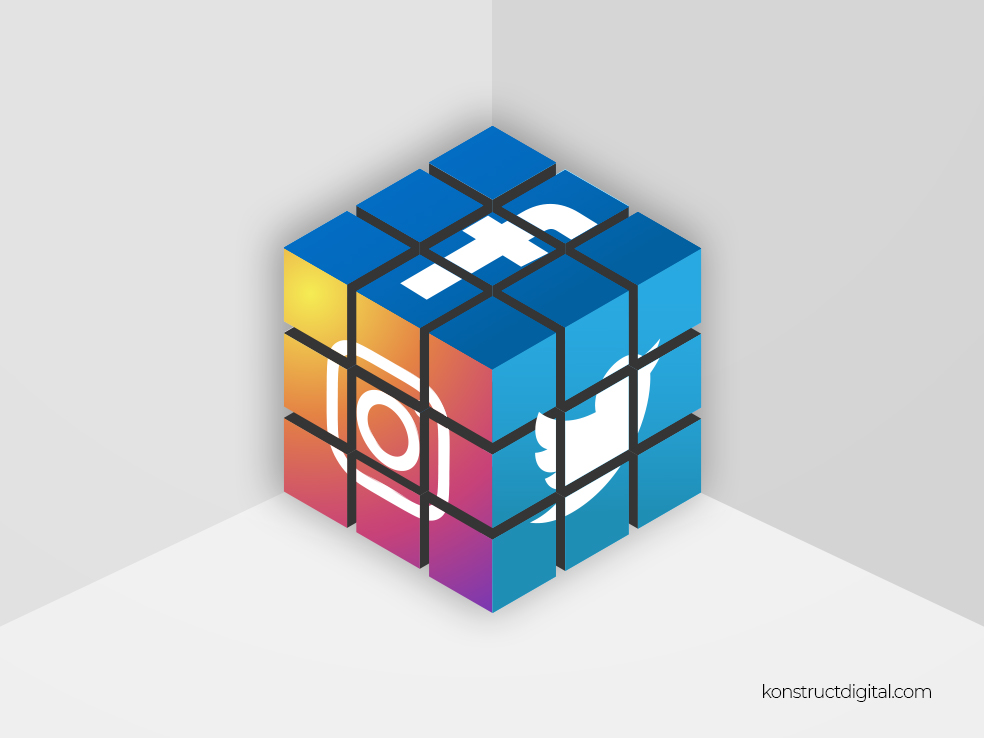Understanding how social media algorithms work is like learning how to solve a Rubik’s Cube. It looks complicated, but once you understand the algorithm, you’ll master the puzzle.
In this article, we will dive deep into unique ways you can boost your social media reach by understanding the true nature of social media algorithms.
What Are Social Media Algorithms?

Social media algorithms are rules that specify how posts will be sorted in each user’s feed. These rules may vary between platforms, but one commonality is that all social media algorithms now sort content based on relevancy rather than in chronological order.
Basically, it’s a set of rules that social media platforms use to determine what you see on their platform.
Platforms such as Facebook, Instagram, Twitter and LinkedIn all use these algorithms to filter through the massive amounts of published content on each of their platforms. These algorithms aim to improve user experience by creating a feed that shows relevant content based on the user’s typical engagement patterns.
Before we discover the top 5 tips, let’s dive into specific social platforms and how their social algorithms work.
This article is a long one so feel free to jump ahead to the section you need:
How Facebook’s Algorithm Works
The mega social network, Facebook, attracts 2.89 billion monthly active users. Although this huge number means a potentially greater reach for your content, it also means you have a lot more competition, making it quite difficult to achieve viewer engagement on organic content. This is why it’s important to understand Facebook’s social media algorithms.
Facebook’s algorithm analyzes users and their common behaviour patterns on the app. The algorithm completes a 4 step process to determine where content should be displayed on a user’s feed. The 4 steps are:
- Ranking available content – Facebook takes all of the relevant content available for each user and scores it based on post type, recency and relevancy.
- Discarding irrelevant content – Upon scoring all of the content, Facebook discards content that is unlikely to generate engagement from the user.
- Analyzing posts that will get the most engagement – After discarding content, it ranks the relevant content based on what the user has typically engaged with in the past.
- Completing a list of content – Once all of the available content is ranked, Facebook’s algorithm has its perfect feed ready for the user to view.
These 4 steps are based on what the user typically engages with. That’s why it’s important to create content for your audience, not for your business.
5 Tips to Master Facebook’s Algorithms
Since Facebook’s algorithm controls the arrangement of content on users’ feeds, it’s essential to create engaging content that the algorithm wants to push onto multiple news feeds. Creating different types of content that are relevant to your target audience and their Facebook activity will show the algorithm that your content is valuable.
Facebook prioritizes content from people and businesses that engage with each other. If your friend constantly engages in a specific type of content, chances are you will see that particular type of content on your feed.
You might be asking: how do businesses create social media marketing strategies to ace Facebook algorithms? Well, let’s dive into our top five unique tips to help you become a Facebook algorithm pro.
- Create Great Content
Let’s look at why great, informational, creative, and unique content is essential in the eyes of Facebook’s algorithm.
User interactions are based on the value of the content that pops up on their feed. Creating great content will have a domino effect on your business’s profile, which tells the Facebook algorithm that users are interested in your posts. If you aren’t sure what type of content to create, try producing videos or engaging graphics. Short videos are increasing in popularity and are a great, eye-catching tool to reel in your customers and catch the algorithm’s attention. Profiles with less than 5k followers have a CTR of 29.66% when using videos, whereas photos only have 3.67% CTR and caption-only posts have 1.96% CTR. That is a big difference!
- Know Your Target Audience
Gain a deeper understanding of your audience, even if it takes up your time. Facebook makes this process relatively easy for businesses by allowing them to view their analytics. Using Facebook Business Suite insights can help you discover the behavioural patterns of your users, which will allow you to schedule content at desirable times and see how your audience engages with your content through likes, shares, comments and more! If you have inconsistencies in your engagement rate, it could very well be because you aren’t creating content for your audience.
Another great feature of Facebook Insights is the ability to discover your audience’s location, age, and placement (how they saw your posts). This allows you to learn more about your audience, which helps you to understand and create content that caters to them. This will give your content a chance at a better reach and higher engagement.
- Choose Your Post Times Wisely
Do not take time for granted (I know, that was deep). Unfortunately, posting content at specific times can be that serious. Although Facebook Insights doesn’t offer a specific time that followers are most active, Buffer did a study that claims the best post times on Facebook were between 1 pm and 3 pm on weekdays and Saturdays. They also discovered that on Thursdays and Fridays, engagement rates were 18% higher.
What does this mean? It’s common knowledge that posting when your followers are most active is important to increase reach.
Although Facebook has no specific posting time recommendations, Brayden Cohen, a Social Media Strategist at Hootsuite, claims, “It’s best to post first thing in the morning because this is when people are catching up on their newsfeeds. Lunchtime is always great because it’s when people tend to have the biggest gaps in their schedules. Just after working hours are effective too because people are checking out what they missed over the day.” So, test out some different posting times based on when you see the most engagement and reach.
- Post Regularly
Schedule your posts. Trust me, hammer out a week or month’s worth of posts and sit back and relax. Scheduled posts ensure you are posting at the right time and posting regularly (are you seeing how all of these tips are fitting together yet?!) Facebook’s algorithm prioritizes active accounts. Now, don’t take this the wrong way — please don’t spam your customers. Plan your posts to perfectly fall into your audience’s laps when they are active on the platform.
- Drive Discussion
It’s almost time to sit in the driver’s seat and speed your car through the Facebook algorithm finish line. First, you must drive the social discussion. You can’t cross the finish line without competing in the race! Change your Facebook status and ask your audience questions, or ask for their comments, feedback, or any other response invoking discussion! This type of interactive content helps you generate engagement and compels Facebook’s algorithm to share your content on more users’ feeds. Upon creating story polls, or commenting/DMing back to users, try finishing your discussion with a CTA (call to action) like “Read more here”, “Register now”, or “Follow us”.
Win Over Facebook Users
With 2.89 billion monthly active users, over 300 million photos uploaded every day, and users averaging 58-minutes spent on Facebook daily, there is a LOT of competition out there. To become the ultimate Facebook algorithm master, you need to work hard and understand how to use the Rubik’s Cube of tips to your advantage.
Facebook is one of many social media empires, and you’re now one step closer to mastering all of the social media algorithms.
How Instagram’s Algorithm Works
Unlike most social media platforms, Instagram has a different algorithm for each of its features. These different algorithms include feed, stories, Instagram TV, Explore, and Reels.
Feed Posts
When a feed post is published, the algorithm dives into action by gathering as much information as possible. The 4 key signals that the algorithm analyzes are:
- Information about the post
- Information about who posted
- User activity
- Everyday interactions that users have with other profiles
It’s as if the algorithm is asking: does this user typically engage with these posts? How interested are they in your content? Who created this content? And more! According to Instagram, the algorithm takes this information and scores it based on the likelihood of someone engaging with your post and then decides where to place your content on users’ feeds.
Story Posts
Instagram’s algorithm treats stories very similarly to feed posts. It reads the post and scores it based on the content. The stories that pop up first on your feed are from accounts that you are engaging with most. One great way to consistently be at the front of the story feed is to create engaging stories like polls and questionnaires.
Explore Page
The algorithm chooses all of the content on the Explore page based on the type of posts that users commonly interact with. The main difference between the Explore page and the story/feed algorithm is that the Explore page typically contains content creators that you don’t already follow. If you constantly publish engaging content with niche hashtags and strong captions, you are more likely to be featured on the Explore page.
Instagram Tv
Instagram’s new Instagram TV feature combines all published video content, including IGTV content — which longer exists. Instagram claims that these “videos are personalized to you, making it easier to discover and watch content from Creators you follow—or may want to follow.” This indicates that the algorithm treats Instagram TV the same way it treats all published content. The algorithm promotes Instagram TV based on who you typically interact with most. It assumes what content users like content based on their previous activity and then pushes that content towards them.
Reels
The reels algorithm pushes rich, visually appealing media. According to Instagram, rich media on reels includes high-quality content with a limited amount of text that does not contain a border (or the TikTok watermark!). This will show Instagram that your content is valuable to your users, and your reels may get pushed to the top of users’ feeds.
Tips to Master Instagram’s Algorithm
Instagram is slowly migrating over to a business and shopping platform. This is excellent news for you! With personal account posts (non-influencing accounts) becoming less popular, users follow their favourite celebrities, companies, and brands. So what makes you stand out?
Let’s take a look at 5 handy tips that will help you increase your reach, so I can prove to you that your business can thrive if you master Instagram’s algorithmic puzzle.
- Post Striking Content
Instagram is a photo-based platform, so visuals are EVERYTHING. I mean that. They are literally everything. Users care about captions, but not nearly as much as they care about seeing what Kylie Jenner’s new bathing suit looks like or what Cristiano Ronaldo is doing on his yacht. Instagram has made photography and graphic design thrive. Your first step to mastering the algorithm and coming up on top is to create eye-catching material that users will like, comment, save and re-post on their stories.
According to Sprout Social, ranking higher in your follower’s feeds goes hand in hand with “great content”. Meaning, by creating visually striking content that is bold, high-quality and out of the box, your content has a greater chance of ranking higher.
When posting on Instagram, high-quality, long-lasting, and visually appealing content will set you apart from the competition (in the eyes of the algorithm). If you post on your main feed, story, Instagram TV or Reels, customers and the algorithm will be drawn towards your profile. For example, try using different lighting techniques; use a camera or phone to capture high-quality images and videos. If filming a Reel or Instagram TV video with audio — use sound equipment!
There are many ways to create eye-catching content, so before you post, think to yourself: “Would I interact with this if I was the consumer?”. If your answer is no, try and use different techniques and tactics to create that high-quality content.
- #Hashtags, #Hashtags, #Hashtags
Using relevant hashtags allows you to reach your target audience and get up to 79% more engagement. A best practice is to research hashtags that have around 100k-300k posts and add those hashtags to your content. For instance, if you own a small candle business, could use #candlecommunity (164k posts)or #candledecor (178k). The absolute key to using hashtags is to use them effectively without being penalized by the algorithm.
Yup, that’s right, you can cause damage to your business if you misuse hashtags. Instagram may shadowban your content. This banning process can be harmful to your Instagram marketing plans. Instagram has a long list of banned hashtags, and if you use them, your account may be penalized. To find out if a hashtag is banned, search the hashtag you want to use. If you get a message that says that the hashtags are currently hidden and don’t meet community guidelines, the hashtag is banned.
Recently, Instagram reported that using only 3-5 hashtags is ideal. We’re not sure how we feel about this new advice yet but you can try it out with us to see if your reach increases.
- Engage In Relevant Content
As we know, Instagram heavily focuses on user engagement. If your business is highly active on Instagram (without being spammy!), Instagram’s algorithm is more likely to push your content out to reach more people.
Take time to comment, like, message and engage with followers and related businesses. One great way to interact with your industry and audience is to engage with relevant hashtags. After you publish on Instagram, go through your hashtags, find companies or brands similar to you, and engage with them. Engaging in relevant content is necessary to help you use the algorithm to your advantage. As you engage with this content, you may also have a higher chance of users interacting with your content, and if the algorithm sees your content gaining more engagement, they will push your posts out to more users!
- Stay Up to Date on all New Instagram Features
Instagram releases new features quite frequently, and if you catch on quickly, your content may be prioritized by the algorithm. Like any business, Instagram prioritizes and pushes its new features to try and reach a wider audience. Staying on top of the latest features and trends will tell Instagram that your business is relevant, engaged and reputable. Keep up to date on new Reels effects, shopping tags, story effects, and more to give your posts the best shot at reaching a larger audience.
Are you tired of hearing the word “engagement” or “reach” yet? If so, hang in there. Engagement and reach are everything to social media algorithms.
5. Consistency is Key
Post like there’s no tomorrow, but don’t be spammy. If you have a following and post when your users are most active, your content has a good chance of reaching the top of their feeds. According to Later, accounts with under 1k followers should post 14 times a week, accounts with 1k-250k followers should post 14-20 times per week and accounts with 250k+ followers should post once a week to achieve the best reach.
Users are more likely to interact with the content shown first on their feed, and you need to take advantage of this. Suppose you schedule posts based on when your audience is most active on Instagram and post consistently; the algorithm will assume your account is reliable and relevant to your industry, resulting in priority feed placement.
Information about Instagram post times can be found directly in your Instagram app! Find out when your followers are most active, and try to post at that time. Here are the steps you can take to find this out:
- Open the Instagram app
- Go to your profile
- Click the 3 lines in the top right corner
- Click on “Insights”
- Click on “Total Followers” (just under “Your Audience”)
- Scroll to the very bottom to see when your followers are most active!
Win Over Instagram Users
Once you have successfully followed our algorithm tips, you have a better chance of increasing your engagement, which will encourage the algorithm to share posts from your profile. Instagram reaches just over 1 billion active monthly users, with 1,074 photos posted on Instagram every second. Now let’s be optimistic. Yes, that is A LOT of users, but think of all the customers you have yet to reach! Be experimental and try new things.
Move those Rubik’s Cube squares and know that you are halfway through this algorithmic puzzle. Shortly, you will become a master of all social media algorithms!
How Linkedin’s Algorithm Works

LinkedIn is such a powerful yet specific platform. Your content may need to look more professional, business savvy, and unique. After publishing a post, LinkedIn reviews your content and places it within three buckets: spam, low quality and high quality.
Here’s how LinkedIn’s algorithm decides which bucket is best suited for your content.
Spam
The LinkedIn spam filter is relatively easy to get around. Spam content may look like a post with spelling errors, poor grammar, 5+ tagged accounts, irrelevant hashtags or multiple links. Ensure you double-check all of your content before it’s published. Using another set of eyes from a coworker, friend, or family member can help you ensure your work’s quality will pass LinkedIn’s spam filter.
Low Quality
Once the algorithm decides that your content is not spam, it begins to test your post. Regardless of whether your post is just a caption, an image, a video or all of the above, LinkedIn will push your content ever so slightly to see how well it engages your audience. LinkedIn’s algorithm will decide if it should increase the reach of your post, show it less frequently, or remove it from users’ feeds based on your initial engagement rates. So, make sure you spend time engaging on LinkedIn immediately after publishing in order to break into the high-quality bucket.
High Quality
The difference between low or high-quality content is based on a fine line of algorithmic equations. High-quality content may include easy-to-read formatting, niche content, engaging captions (ending your content with a question), solid keywords and only a few tagged users that are likely to respond. High-quality content will tell LinkedIn’s algorithm that you know what you’re talking about and that your content may be engaging for more users. Ensure your content is grammatically correct, purposeful and relevant to place in the high-quality bucket.
Tips to Master Linkedin’s Algorithm
Discover more ways that will help you stand out from the crowd on LinkedIn. Use these 5 tips to help increase your engagement with the help of the LinkedIn algorithm.
- User Engagement Determines Your Post Performance
Within the first hour of posting, your engagement levels are measured to see if your content is worth being displayed on a broader range of user feeds. What does this mean? If your post gets no comments or likes, you may not be ranked, leaving you with deadbeat content. How disheartening!
The first hour after you post is when the algorithm determines the placement of your content. I advise you to take at least twenty minutes after publishing your post to interact with your peers and other companies’ content on LinkedIn. Another great way to increase your engagement and be seen by the algorithm is to encourage your employees to interact with your LinkedIn content. Employee engagement has many benefits to increasing your LinkedIn reach.
I’ve said it once, and I will say it again, engagement and reach are EVERYTHING.
- Spam Proof Content
As previously mentioned, spam content can completely ruin your post. That’s why it’s crucial to spam-proof your posts! Create meaningful content, use appropriate hashtags (this is important! Misusing hashtags will tell LinkedIn that your content is spam), and don’t post multiple times a day, tagging 10+ people. It won’t improve your reach!
- Personal Contacts > Famous Profiles
If you have spent any time on LinkedIn, you will know that personal connections run the platform. Ensure your employees are linked to your profile, interact with relevant people, and engage with your peers.
I’m sorry to break it to you, but the chances of a celebrity reacting to your content are very slim. If you create basketball content, I would take the time to tag relevant peers or connections rather than Shaquille O’Neal’s LinkedIn profile. Embracing these relevant connections can show the algorithm that your content is high-quality, resulting in your content being placed at the top of more feeds.
- Post Consistently
Did you know that of the 500 million LinkedIn users, only 3 million post weekly? Your target audience is out there, and consistent posting is a great way to reach them. Posting valuable content anywhere between 2-5 times a week is a great way to show the algorithm that your posts are consistent and have meaning.
However, if you post 5 times a week but your content is bland or spammy, the algorithm will put you in the spam bucket, and you will do more harm than good. Your mission when posting content on LinkedIn should be to place quality over quantity.
- Relevant Hashtags
If you’re starting to think that all of these tips are the same for each platform, to some extent, you are right; but technically, you’re not. Every social platform treats users and their posts differently. Hashtags are used in different ways on Instagram, Facebook and LinkedIn.
You can search for any hashtag in the search bar of your LinkedIn account, allowing you to see relevant posts and other related hashtags. By using relevant and niche hashtags to your topic, your LinkedIn posts are much more likely to be seen. LinkedIn’s former project manager, Pete Davis, recommends using a maximum of 3 hashtags in your LinkedIn posts. He also recommends that you use niche hashtags instead of broad and overused ones. Don’t use #likethisplease #comment4commentback #follow4follow as the algorithm will likely mark your post as spam.
Win Over LinkedIn Users
LinkedIn’s 500+ million users give you the opportunity to reach consumers from all over the globe. On average, 2 million photos, videos and articles are posted every day. Wow, think about that for a second. LinkedIn is a much smaller platform than Instagram and Facebook, with significantly fewer posts published each day. This smaller audience gives you a better chance of reaching your consumers.
Now don’t think this means there is no competition; many B2B companies ONLY use LinkedIn! I’m saying that you have a better chance of actually reaching your target audience, whereas, on Instagram or Facebook, you may struggle a bit more.
How Twitter’s Algorithm Works
Tweet, tweet, are you still here? Twitter is the last social media platform we’ll cover in this article!
Founded in 2006, Twitter has been growing ever since! Some social media users think that Twitter is a dying platform, but in reality, they have always been slowly growing (excluding some small dips). With 330 million monthly active users, it’s important to keep Twitter in mind when planning around Twitter’s social media algorithm. Remember, Twitter’s algorithm looks at the recency of your social content above everything else.
Although Twitter is a less popular platform, it might still be worth your time. Like most social platforms, Twitter’s algorithm prioritizes recently posted content and content with the most engagement.
Tips to Master Twitter’s Algorithm
Like the previous social platforms, they all have similar features that make their algorithms different. A few ways to please Twitter’s algorithm is to tweet content containing at least 2 hashtags, utilize all 280 characters, and include relevant images.
Let’s look at 5 tips that will help the Twitter algorithm boost your content.
- Time Is Of The Essence
Have you taken the time to look at your user insights? Well, tick-tock, get on with it! Twitter’s algorithm works quickly! It can analyze your tweet within minutes, meaning you need to be on the ball with your content. Once your tweet goes live, try to begin engaging with other relevant content, and if you’re getting retweets or replies, try to respond to them as quickly as you can. If the algorithm notices engagement coming from your recent tweets, they are more likely to place it at the top of users’ feeds. If your followers are quickly scrolling through Twitter, casually browsing, or looking for specific tweets — your content has a better chance of being read!
- Get Engaged With Your Audience
It is now time to pop the big question: “Will you follow me?” Twitter users are more likely to follow you, retweet, like, and reply to your content if you are an engaging brand. Twitter’s algorithm looks for ways that users interact with your brand and your tweets.
Twitter has an engagement feature that allows you to create polls on your tweets. This is a great way to engage with your audience while understanding their opinions and feedback. If you start a conversation, use engaging features like polls, retweet customer posts or stay up to date with the latest industry news, you have a good chance of being seen by the algorithm. Remember, like any engagement, it takes two people to build and develop a relationship!
- Know Your Audience
Do you really know your audience? Don’t forget that your target audience is similar on every platform but their behaviour may vary drastically from platform to platform. Your customers may be highly active on Instagram and Facebook, but seemingly non-existent on Twitter. If you use Twitter as a social platform for your business, follow the Twitter trends and analyze your tweets with Twitter’s analytics to see who is most actively engaging with your content and which posts perform the best.
Did you know that 42% of Twitter users are between the ages of 18-29? If your target audience is outside of that age range, Twitter might not be worth your time! As we know, engagement is everything. If your audience isn’t actively engaging in your Twitter content, the algorithm won’t place your content anywhere near the top of the user’s feeds, ultimately making your content useless. If you believe that your audience is out there, then it’s time to face them head-on.
So how do we confront the Twitter users? By getting to know them! Twitter is a casual yet informative platform. The more you understand the user, the more they will engage, and the more the Twitter algorithm will extend the reach of your content!
- Include Photos in Your Content
Twitter’s algorithm loves photos and video content. From memes and gifs to a news broadcast, the algorithm prioritizes these posts. Did you know tweets with video content get 10 times more engagement than those that don’t? It’s evident that visuals are what can ultimately carry some of your social posts, so consider including them in most of your content. If you’re not already, it’s time to start including photos and videos in your tweets.
- Create Content that Engages Customers
To the Twitter algorithm, engagement is pretty much the most important thing. If you create content specifically for user engagement, Twitter will analyze it and increase the reach. Creating content that includes polls, memes, or hashtags is a great starting point to engaging content. Twitter’s algorithm prioritizes profiles with continuous interaction and engagement with followers, as they look for consistency over one-hit wonders.
One great example of creating constant engaging content on Twitter is how brands are starting to humanize and have fun with their social media through tweets. A common tweet pattern by Netflix, Wendy’s, Denny’s and more, is their take on memes based on what they know their customers are most interested in; for example, Netflix promoted the classic, A Cinderella Story, with a relatable Jennifer Coolidge meme compilation. This tweet and many other Netflix tweets are fun, casual and create that reach and engagement that is oh-so-necessary for Twitter’s algorithm.
Twitter’s casual tone creates an ideal space for you to really get to know your audience. By developing creative ways to increase engagement through memes and other provoking conversations, Twitter’s algorithm will notice your profile and will help you reach more engaged followers.
Win Over Twitter Users
With 500 million tweets sent a day, these 5 tips will hopefully help you win over Twitter users and use the Twitter algorithm to your advantage! Don’t forget, Twitter has a small character count (280 characters), so make sure you create content for that length while still keeping it valuable for your audience! If you start following these tips in your everyday social media strategy, you are bound to master Twitter’s algorithm.
You Are Now a Social Media Algorithm Master!

The moral of the story: engagement and reach are EVERYTHING. See, I told you I’d say it again. Thanks for sticking around to the end of this article! You now know many tips that can help you boost your engagement and master social media algorithms.
I know, I know, this has been a long article, and you’re probably wondering: how do I manage all of these social media algorithms at once? Let us help you! At Konstruct Digital, we help our clients with all of their social media content needs. From social media posts for your Instagram, LinkedIn, Twitter and Facebook to crossposting on your website, Konstruct can do it all! We know this can be a tedious and stressful process. Contact us today to succeed in the social media marketing world!
Need help with B2B Content?
Learn more about Konstruct's B2B Content Services
More B2B Content Resources
- Should You Replace Your Content Marketer with AI? Maybe…
- LinkedIn B2B Marketing Examples That Made Us Say, “$h!t, I wish I thought of that!”
- 9 B2B Social Media Dos and Don’ts That’ll Change Your Social Game
- Stop Snoozing on These 7 B2B Content Marketing Trends
- B2B Marketing Copywriting: 10 Tips for Writing Persuasive Copy for Today’s B2B Buyers
- 9 Wow-Worthy B2B Content Marketing Examples To Inspire Your Content Strategy
- 8 Irrefutable B2B Social Media Marketing Benefits
- The Proven Formula for a Rock-Solid LinkedIn Content Strategy
- Content Marketing Statistics: The Facts You Can’t Afford to Ignore
- 999,999 Tips for Creating On-Brand SEO Content


